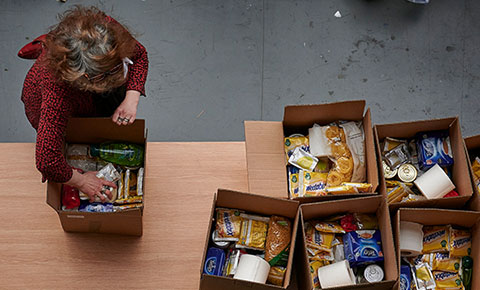COVID Impacts Leave More Families Hungry
 The amount of economic distress families are facing requires “an urgent and sustained response from the federal government,” according to a new analysis of food insecurity by Northwestern University professor and economist Diane Schanzenbach and research analyst Abigail Pitts.
The amount of economic distress families are facing requires “an urgent and sustained response from the federal government,” according to a new analysis of food insecurity by Northwestern University professor and economist Diane Schanzenbach and research analyst Abigail Pitts.
The report analyzed data from the COVID Impact Survey to describe levels of food insecurity by race, income, and presence of children in April 2020.
Schanzenbach, director of the Institute of Policy Research, and Pitts found that the rate of people worrying about having enough money for food was “substantially larger than what would have been predicted, especially among families with children.”
Their data suggests that food insecurity remains elevated and statistically unchanged, with food insecurity rates twice as high overall — and nearly three times as high among respondents with children — as they were predicted to be in March.
While the COVID-19 crisis affected nearly everyone in some way, it has been especially disruptive for low-income working families with children. Unemployment has spiked sharply, and families have lost income, increasing their economic hardship.
At the same time, millions of children have lost access to subsidized school meals that play a key role in helping families with children meet their basic food needs due to widespread physical school closings.
Surveys taken since the COVID-19 pandemic began have documented dramatic increases in food insecurity as well as very low food security—a more severe condition of disrupted or reduced food intake—among adults, children, and other vulnerable population, wrote Schanzenbach, a professor in the School of Education and Social Policy, and Pitts.
Their latest results show:
- Between the April and May surveys, food insecurity declined among white respondents and increased among black respondents. In May, a majority of black respondents with children reported they were food insecure.
- Seven percent of respondents reported receiving benefits from food pantries over the prior 7 days, a rate that was statistically unchanged across the two months.
- Within families, adults do their best to protect children from hunger by cutting their own food intake first.
- A substantial share of respondents report applying in the past seven days for benefits from Unemployment Insurance (UI) or the Supplemental Nutrition Assistance Program (SNAP), with declines in reported applications across the different reporting periods.
- Rates of food insecurity and food pantry use continue to vary widely across states and metropolitan areas represented in the survey. Louisiana had the highest estimated rate of food insecurity, with more than 1 in 3 respondents reporting being food insecure. Among the metro areas, food insecurity was highest in the Birmingham, Columbus (Ohio), Chicago, and Phoenix metro areas.
For more information, read their full data analysis from the COVID Impact Survey. You can follow Schanzenbach on Twitter @dwschanz and @IPRatNU for more on her ongoing research about food insecurity during COVID-19.